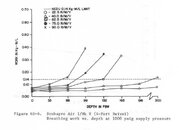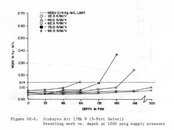Mr. John, the volume does exactly remain the same at depth. What varies is density of the gas and therefore the mass flow changes in relationship with the density of the gas.
The turret in a Mark V or a Mark 25 acts as a plenum, the direction of the ports out of the turret is somewhat unidirectional.
You guys can believe the top turret port provides a substantial and noticeable increase in flow to the diver over the turret side ports if you want. It can only deliver what the diver demands. As I said, even elite athletes top out around 8 cfm, your stressed diver with a bag of clams is not likely to exceed that amount. That is why he had a heart attack. People have a heart attack shoveling snow. An aquantence of mine had a heart attack on his bicycle in a race and crashed. Fortunately he is going to be okay and has a new heart stint or something like that. Has nothing to do with which first stage port the diver is breathing from. Anecdotal examples just do little for me as proof of anything.
Oh well. Yes, if you get a copy of that please share it. In any case, I am sort of tiring of this thread, but I would like to read that paper please. Thanks. Love you Mr. John

.





 .
.